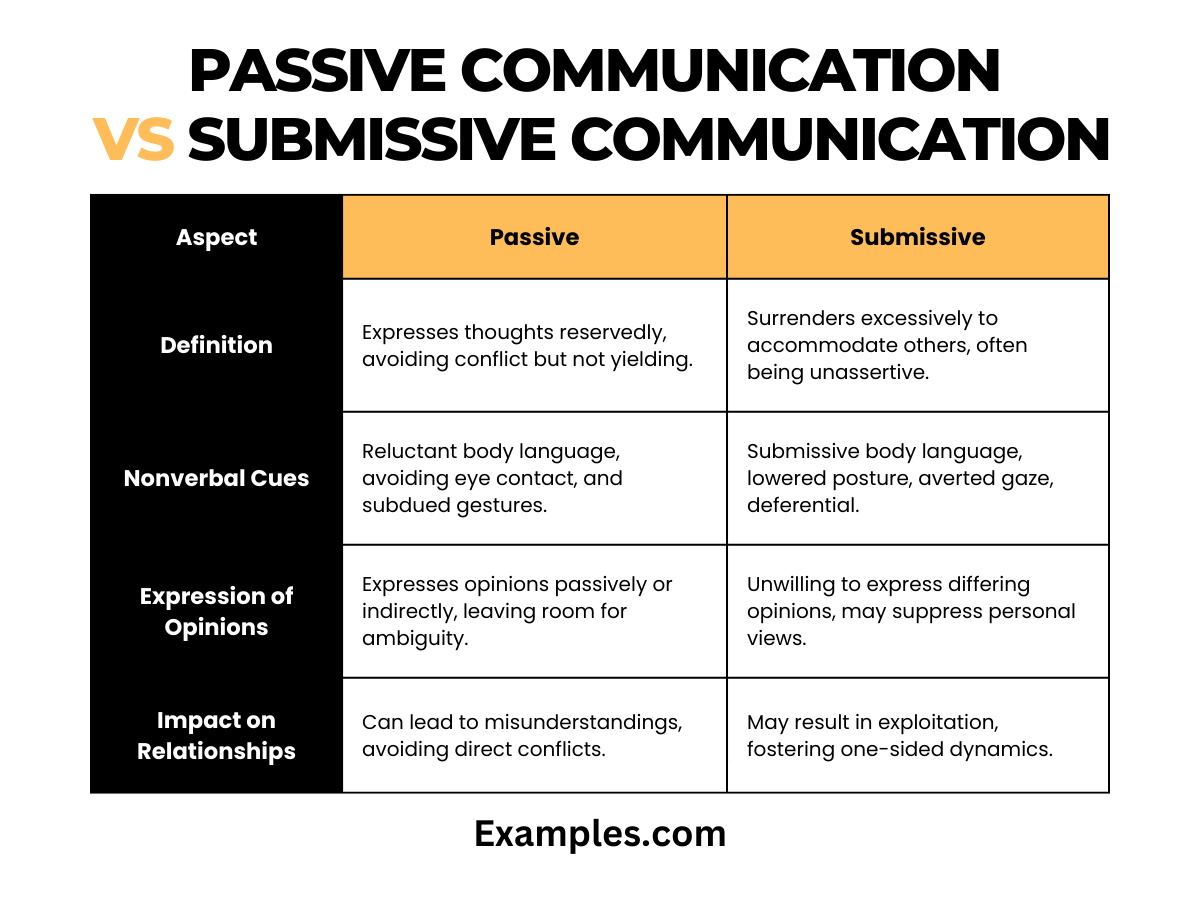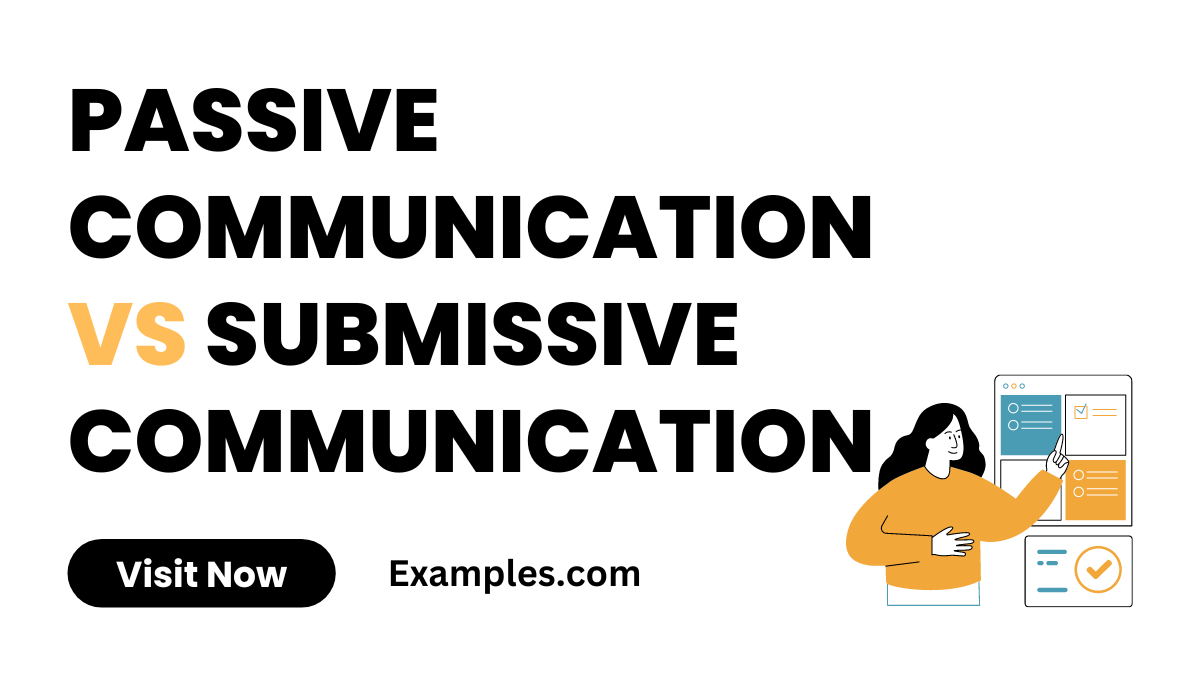Passive Communication vs Submissive Communication – 19+ Examples
Unlock the nuances of human interaction with our comprehensive guide on Passive vs Submissive Communication. Delve into vivid Communication Examples, dissecting the subtle differences and mastering the art of expressing yourself assertively. Enhance your social skills and navigate diverse scenarios seamlessly with practical insights. Explore the transformative power of effective communication in real-world situations, illuminating the path to personal and professional success.
Difference Between Passive Communication and Submissive Communication
Understanding the distinctions between passive and submissive communication is crucial for cultivating healthier interpersonal dynamics. Striking a balance between expressing oneself assertively and respecting others’ perspectives fosters effective communication and mutual understanding.

| Aspect | Passive Communication | Submissive Communication |
|---|---|---|
| Definition | Involves expressing thoughts and feelings in a reserved manner, often avoiding conflict but not necessarily yielding to others’ demands. | Characterized by self-effacement, surrendering one’s needs and desires excessively to accommodate others, often leading to unassertiveness. |
| Nonverbal Cues | Reluctant body language, avoiding eye contact, and subdued gestures may accompany passive communication. | Typically accompanied by submissive body language, such as lowered posture, averted gaze, and overall deferential nonverbal signals. |
| Expression of Opinions | May express opinions passively, indirectly, or with hesitation, often leaving room for misinterpretation. | Unwilling to express differing opinions, tends to agree with others, and may suppress personal viewpoints to maintain harmony. |
| Impact on Relationships | Can lead to misunderstandings and unmet needs but may avoid direct conflicts. | May result in exploitation by others, fostering a one-sided dynamic where the submissive individual’s needs are often overlooked. |
| Assertiveness Level | Generally lacks assertiveness, but not necessarily submissive; may still stand firm on certain issues. | Demonstrates low assertiveness and may struggle to assert personal rights or boundaries, leading to a higher likelihood of exploitation. |
| Communication Style | Tends to be indirect, veiled, or ambiguous in communication, often relying on others to infer underlying thoughts and emotions. | Places high importance on pleasing others, leading to over-accommodation and sacrificing one’s needs and desires for the sake of harmony. |
| Empowerment Approach | Passive communication can sometimes involve strategic choices to maintain harmony or avoid unnecessary conflicts. | Submissive communication may result from a lack of self-empowerment, fostering dependency on others’ approval and validation. |
10 Passive Communication Examples
Passive communication offers benefits in certain situations, allowing individuals to navigate delicate scenarios with subtlety. This approach can foster a calm atmosphere and prevent unnecessary conflicts, making it valuable in various interpersonal contexts.
- Silent Agreement:Sometimes, silence can convey agreement without explicitly stating it, maintaining a peaceful interaction.
- Non-Verbal Nod:A simple nod can express consent without verbalizing, providing a non-confrontational way to agree.
- Avoidance of Disagreement:Choosing not to engage in a disagreement can prevent unnecessary tension, promoting a harmonious environment.
- Polite Decline:Politely declining a request without detailed explanations can be a gentle way to communicate limitations.
- Tactful Silence:Remaining silent during sensitive conversations can communicate empathy and respect for the speaker.
- Soft Refusal:Using soft language to refuse requests helps maintain relationships without causing discomfort.
- Gentle Critique:Offering constructive feedback with a gentle tone can communicate concerns without appearing confrontational.
- Implicit Cooperation:Implicitly cooperating with others’ preferences can create a collaborative atmosphere without explicit negotiation.
- Indirect Recognition:Expressing acknowledgment indirectly can affirm others without direct verbal praise.
- Selective Disclosure:Choosing when to disclose information selectively can protect boundaries while maintaining a cooperative environment.
10 Submissive Communication Examples
Submissive communication, often misconstrued, possesses its unique benefits. By prioritizing harmony and accommodating others, it fosters cooperative relationships. In team settings, a submissive communicator may enhance group cohesion and minimize conflicts.
- Agreeable Language: Submissive communicators tend to agree easily, maintaining a pleasant atmosphere even during disagreements. For instance, “I see your perspective, and I appreciate your insights.”
- Soft Tone: Using a soft and gentle tone contributes to a calm communication style. “I understand your concerns, and I’m open to finding a solution together.”
- Active Listening: A submissive communicator excels in active listening, allowing others to express freely. “I hear what you’re saying, and I value your input.”
- Apologizing Profusely: Submissive communicators often apologize excessively, seeking to avoid conflicts. “I’m sorry if my opinion caused any discomfort; I respect your views.”
- Preferring Consensus: Prioritizing group harmony, submissive communicators strive for consensus. “Let’s find a solution that works for everyone.”
- Avoidance of Criticism: Submissive communicators refrain from criticizing others directly. “I appreciate your efforts, and I believe we can work together for improvement.”
- Emphasis on Others’ Needs: Submissive communication involves placing emphasis on others’ needs. “What can I do to support you better?”
- Expressing Gratitude: Frequent expressions of gratitude enhance a submissive communicator’s interactions. “Thank you for considering my input; I value our collaboration.”
- Seeking Approval: Submissive communicators often seek approval to ensure alignment. “Do you think my proposal aligns with our team goals?”
- Consoling Others: Offering comfort and understanding is a common trait. “I understand this is challenging; I’m here to support you.”
Comparison Between Passive Communication and Submissive Communication
Understanding the nuances between passive and submissive communication is crucial for effective interpersonal dynamics. While both styles prioritize avoiding conflicts, they differ in their underlying motivations and expressions.
1. Intentions:
- Passive Communication: Primarily focuses on self-preservation by avoiding confrontation or disagreement.
- Submissive Communication: Aims to prioritize others’ needs, seeking to maintain harmony and minimize tension.
2. Expression:
- Passive Communication: Involves a reluctance to express personal opinions or desires openly.
- Submissive Communication: Expresses opinions but often in a self-effacing manner, placing others’ needs above one’s own.
3. Decision-Making:
- Passive Communication: Tends to avoid making decisions, deferring choices to others.
- Submissive Communication: May express preferences but readily accepts others’ decisions, avoiding conflict.
4. Assertiveness:
- Passive Communication: Lacks assertiveness and may struggle to communicate personal boundaries.
- Submissive Communication: Assertiveness is present but tends to be overshadowed by a strong desire for agreement and consensus.
5. Handling Criticism:
- Passive Communication: Typically avoids confronting or responding to criticism directly.
- Submissive Communication: May accept criticism readily, often internalizing it to maintain harmony.
6. Response to Conflict:
- Passive Communication: Withdraws from conflicts, often leaving issues unresolved.
- Submissive Communication: Seeks compromise and conciliation, prioritizing relationship preservation.
7. Influence on Others:
- Passive Communication: May inadvertently encourage others to dominate or control situations.
- Submissive Communication: Often encourages collaborative decision-making, influencing others towards consensus.
8. Empathy and Understanding:
- Passive Communication: May struggle to express or fully comprehend others’ perspectives.
- Submissive Communication: Demonstrates empathy, actively listening and considering others’ viewpoints.
9. Self-Expression:
- Passive Communication: Inhibits self-expression to prevent potential disagreements.
- Submissive Communication: Expresses personal thoughts, but with a focus on maintaining a positive atmosphere.
10. Workplace Dynamics:
- Passive Communication: May lead to unspoken tension and unaddressed issues in professional settings.
- Submissive Communication: Fosters collaborative teamwork but may result in personal needs being overlooked.
In navigating the realm of interpersonal communication, understanding the distinctions between passive and submissive approaches is pivotal. While both aim to avoid conflicts, passive communication leans towards self-preservation, whereas submissive communication prioritizes the needs of others. Striking a balance between the two ensures harmonious interactions, emphasizing assertiveness without sacrificing empathy. Explore these nuances to enhance your communication skills and cultivate healthier relationships.



